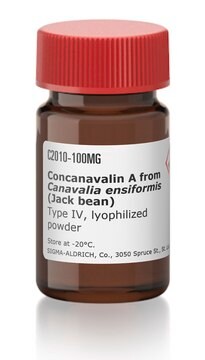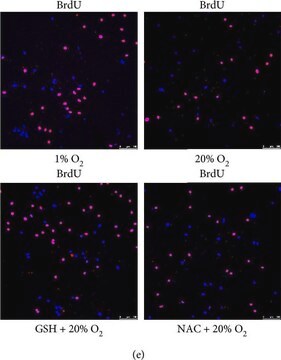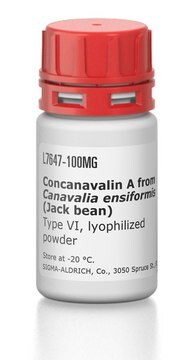C5275
Concanavalin A from Canavalia ensiformis (Jack bean)
Type IV-S, lyophilized powder, aseptically processed, BioReagent, suitable for cell culture
Synonym(s):
Con A
Sign Into View Organizational & Contract Pricing
All Photos(1)
About This Item
Recommended Products
sterility
aseptically processed
Quality Level
type
Type IV-S
product line
BioReagent
form
lyophilized powder
technique(s)
cell culture | mammalian: suitable
impurities
salt (Contains buffer salts and NaCl)
solubility
PBS: 5 mg/mL, slightly hazy
H2O: soluble, slightly hazy
storage temp.
−20°C
Looking for similar products? Visit Product Comparison Guide
Related Categories
General description
Concanavalin A is a protein containing only β-sheets in its structure, and belongs to the legume lectins family.
Application
Concanavalin A from Canavalia ensiformis (Jack bean) has been used:
- in in vitro cell proliferation assay and cell cycle assessment
- in lymphocyte proliferation
- in splenocyte culturing
Biochem/physiol Actions
Concanavalin A is known to stimulate acute hepatic inflammation and acts as a T‐cell mitogen. It has inhibitory effect on hepatocellular carcinoma by inducing autophagy.
Con A is not blood group specific but has an affinity for terminal α-D-mannosyl and α-D-glucosyl residues. Ca2+ and Mn2+ ions are required for activity. Con A dissociates into dimers at pH 5.6 or below. Between pH 5.8 and pH 7.0, Con A exists as a tetramer; above pH 7.0 higher aggregates are formed. Con A exhibits mitogenic activity which is dependent on its degree of aggregation. Succinylation results in an active dimeric form which remains a dimer above pH 5.6.
Analysis Note
A lymphocyte transformation assay is used to determine suitability for cell culture applications. The mitogenic activity of this product is assessed by bromodeoxyuridine incorporation and is found to have peak incorporation at ≤75 ug lectin/ml of medium.
Where reported, agglutination activity is expressed in μg/ml and is determined from serial dilutions in phosphate buffered saline, pH 6.8, containing Ca2+ and Mn2+ of a 1 mg per mL solution. This activity is the lowest concentration to agglutinate a 2% suspension of human erythrocytes after 1 hr incubation at 25 °C.
Where reported, agglutination activity is expressed in μg/ml and is determined from serial dilutions in phosphate buffered saline, pH 6.8, containing Ca2+ and Mn2+ of a 1 mg per mL solution. This activity is the lowest concentration to agglutinate a 2% suspension of human erythrocytes after 1 hr incubation at 25 °C.
related product
Product No.
Description
Pricing
Signal Word
Danger
Hazard Statements
Precautionary Statements
Hazard Classifications
Repr. 2 - Resp. Sens. 1 - Skin Sens. 1
Storage Class Code
11 - Combustible Solids
WGK
WGK 3
Flash Point(F)
Not applicable
Flash Point(C)
Not applicable
Personal Protective Equipment
dust mask type N95 (US), Eyeshields, Gloves
Choose from one of the most recent versions:
Already Own This Product?
Find documentation for the products that you have recently purchased in the Document Library.
Customers Also Viewed
Effect of Varying Proportions of Lignin and Cellulose Supplements on Immune Function and Lymphoid Organs of Layer Poultry (Gallus gallus)
Hussein SM and Frankel TL
The journal of poultry science, 0180032-0180032 (2018)
Amyloid fibrils formation and amorphous aggregation in concanavalin A
Vetri V, et al.
Biophysical Chemistry, 125(1), 184-190 (2007)
Evaluation of immune functions in captive immature loggerhead sea turtles (Caretta caretta)
Rousselet E, et al.
Veterinary Immunology and Immunopathology, 156(1-2), 43-53 (2013)
Effect of Tapentadol on Splenic Cytokine Production in Mice
Franchi S, et al.
Anesthesia and Analgesia, 124(3), 986-995 (2017)
Concanavalin A induces autophagy in hepatoma cells and has a therapeutic effect in a murine in situ hepatoma model
Chang CP, et al.
Hepatology, 45(2), 286-296 (2007)
Our team of scientists has experience in all areas of research including Life Science, Material Science, Chemical Synthesis, Chromatography, Analytical and many others.
Contact Technical Service











